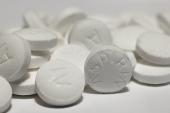USPSTF Finalizes Tougher Stance on Aspirin in Primary Prevention
Accompanied by additional data to help physicians navigate the nuances, the advice echoes a draft document released last fall.

The United States Preventive Services Task Force (USPSTF) has finalized its tougher stance on the use of aspirin for the primary prevention of cardiovascular disease, concluding that people aged 60 or older who do not already have heart disease should not start taking aspirin. The decision to initiate aspirin in those between 40 and 59, meanwhile, should be made on a patient-to-patient basis and only if their individual 10-year risk of CVD is 10% or higher.
“Evidence indicates that the net benefit of aspirin use in this group is small,” members of the USPSTF conclude—the exact same wording used when the group released their draft recommendations last fall. “Persons who are not at increased risk for bleeding and are willing to take low-dose aspirin daily are more likely to benefit.”
Accompanying the recommendations is an updated evidence report and systematic review, an updated modelling study to estimate long-term risks and benefits, several editorials, and a “patient page.”
Stricter Recommendations
The last update from the USPSTF, back in 2016, took a slightly more liberal approach than the document released today, using age 70 as the cutoff for not recommending aspirin. Moreover, the 2016 version did not recommend aspirin for adults younger than 40 without prior CVD, but did stipulate that aspirin could be initiated for the prevention of colorectal cancer—that advice has now been reversed.
The new evidence report and systematic review, led by Janelle M. Guirguis-Blake, MD (Kaiser Permanente, Portland, OR), outlines the data and interpretation supporting that conclusion. Of note, this document appears to have dropped one of the trials originally considered in the draft recommendations and evidence report of last year, which referred to 13 “fair- to good-quality randomized, controlled trials” of aspirin for the prevention of CVD, amounting to a total of 161,680 patients. Today’s paper refers to just 11 randomized controlled trials, for a total of 134,470 patients and one pilot trial of 400 patients. In the updated review and summary, low-dose aspirin was associated with a significant decrease in major cardiovascular disease events (OR 0.90; 95% CI 0.85-0.95), with a similar magnitude of benefit for CVD outcomes analyzed individually. Low-dose aspirin was also associated with significant increases in total major bleeding (OR, 1.44; 95% CI 1.32-1.57).
“Low-dose aspirin was associated with small absolute risk reductions in major cardiovascular disease events and small absolute increases in major bleeding,” Guirguis-Blake and colleagues conclude. Moreover, “colorectal cancer results were less robust and highly variable.”
In the modelling study, led by Steven P. Dehmer, PhD (Health Partners Institute, Minneapolis, MN), which used microsimulation, researchers estimated the long-term benefits and harms for hypothetical cohorts of US men and women aged 40 to 79 years with up to 20% 10-year risk for an atherosclerotic CVD event and without prior history of CVD or elevated bleeding risks. They concluded that any benefit to aspirin in preventing CVD would likely be restricted to patients with a “higher” 10-year CVD risk, who started taking aspirin early on.
As noted by TCTMD when the draft recommendations were posted last year, the new USPSTF advice comes in the wake of a range of trials in different patient subsets that effectively closed the door on aspirin for primary prevention, among them ASPREE in elderly patients, ARRIVE in those at moderate risk for disease, and ASCEND in patients with diabetes. A comprehensive meta-analysis tied those trials up in a bow. As such, this particular US document trails other health organizations that have already taken a tougher stance on aspirin as a means to prevent CVD onset, including the US Food and Drug Administration, the American College of Cardiology/American Heart Association 2019 guidelines for primary prevention, and the 2021 European Society of Cardiology CVD prevention guidelines.
Emphasis on Secondary Prevention
At the time, cardiologists who spoke with TCTMD about the draft document pointed out that while the USPSTF advice was old news to experts in this arena, they feared the messaging to patients might go awry.
“We do need to emphasize that the [USPSTF] guidelines were only for the prevention of a first heart attack or stroke, for primary prevention,” Jeffrey Berger, MD (NYU Langone Health, New York, NY), stressed to TCTMD after the draft recommendations were released. “If somebody is on aspirin because they already have established heart disease or vascular disease, those patients, if their doctor told them to be on aspirin, should remain on it. Nobody should stop their drug, in my opinion, without having a discussion with their healthcare provider.” Berger wrote one of the editorials accompanying the latest USPSTF document.
In a statement, Donald Lloyd-Jones, MD (Northwestern University Feinberg School of Medicine, Chicago, IL), president of the American Heart Association, echoed those recommendations, emphasizing that the new USPSTF guidance is for primary, not secondary, prevention. Low-dose aspirin, he added, is not appropriate therapy for preventing a first MI or stroke “in most people.”
“We continue to urge clinicians to be extremely selective when prescribing aspirin for adults without known cardiovascular disease,” according to Lloyd-Jones, who also wrote an editorial. “For example, people with higher risk for gastric or intracerebral bleeding should not take aspirin to prevent a CV event. Aspirin should be limited to only those adults at the highest risk for cardiovascular disease due to the presence and severity of other risk factors, such as smoking, hypertension, type 2 diabetes, high cholesterol or significant family history, who also have a very low risk of bleeding.
An editorial by Allan S. Brett, MD (University of Colorado School of Medicine, Aurora), published along with the other papers today, tries to put the latest documents in perspective.
“Patients whose general philosophy of medical care is ‘don’t prescribe medication for me unless there is strong evidence to support it” should not start aspirin prophylaxis, whereas those who favor preventive interventions even in borderline cases could reasonably opt for taking aspirin,” Brett writes. But other patients may “ask a trusted clinician to decide for them,” he continues, “while another group will want a detailed discussion and predictions of individualized net benefit.”
That goal, however, “is illusory,” he says. “And clinicians should not pretend otherwise. For such patients, the best approach is for clinicians to be knowledgeable about the data on primary prevention with aspirin. Close reading of the new USPSTF guideline and its companion evidence review, and becoming familiar with the three more recent aspirin trials, is a good way to prepare for these clinical encounters.”
Shelley Wood is the Editor-in-Chief of TCTMD and the Editorial Director at CRF. She did her undergraduate degree at McGill…
Read Full BioSources
US Preventive Services Task Force. Aspirin use to prevent cardiovascular disease: US Preventive Services Task Force recommendation statement. JAMA. 2022;327:1577-1584.
Guirguis-Blake JM, Evans CV, Perdue LA, et al. Aspirin use to prevent cardiovascular disease and colorectal cancer: updated evidence report and systematic review for the US Preventive Services Task Force. JAMA. 2022;327:1585-1597.
Dehmer SP, O’Keefe LR, Evans CV, et al. Aspirin use to prevent cardiovascular disease and colorectal cancer: updated modeling study for the US Preventive Services Task Force. JAMA. 2022;327:1598-1607.
Brett AS. Should patients take aspirin for primary cardiovascular prevention? Updated recommendations from the US Preventive Services Task Force. JAMA. 2022;327:1552-1554.
Jin J. Use of aspirin to prevent cardiovascular disease. JAMA. 2022;327:1624.
Disclosures
- All members of the USPSTF receive travel reimbursement and an honorarium for participating in USPSTF meetings, and disclose any relevant conflicts of interest according to USPSTF regulations, noted here: https://www.uspreventiveservicestaskforce.org/uspstf/about-uspstf/conflict-interest-disclosures





Comments